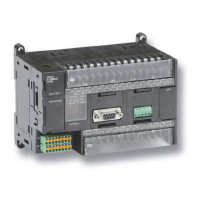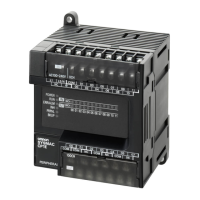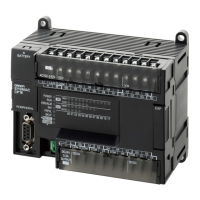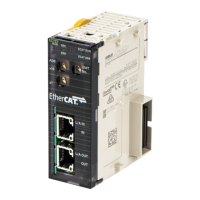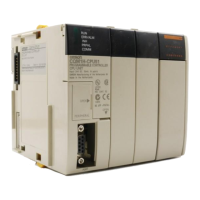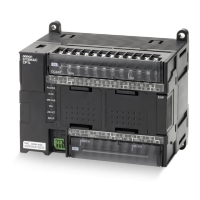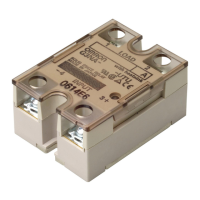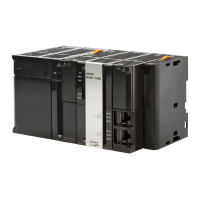198
Pulse Outputs Section 5-2
■ Automatic Direction Selection for Easy Positioning with Absolute
Coordinates
When operating in absolute coordinates (origin defined or PV changed with
the INI(880) instruction), the CW/CCW direction will be selected automatically
when the pulse output instruction is executed. (The CW/CCW direction is
selected by determining whether the number of pulses specified in the
instruction is greater than or less than the pulse output PV.)
■ Triangular Control
Triangular control (trapezoidal control without a constant-speed plateau) will
be performed during positioning executed by an ACC(888) instruction (inde-
pendent) or PLS2(887) instruction if the number of output pulses required for
acceleration/deceleration exceeds the specified target pulse Output Amount.
■ Change Target Position during Positioning (Multiple Start)
When positioning was started with a PULSE OUTPUT (PLS2(887)) instruc-
tion and the positioning operation is still in progress, another PLS2(887)
instruction can be executed to change the target position, target speed, accel-
eration rate, and deceleration rate.
■ Switch from Speed Control to Positioning (Fixed Distance Feed Interrupt)
A PLS2(887) instruction can be executed during a speed control (continuous
mode) operation to change to positioning mode (independent mode). This
feature allows a fixed distance feed interrupt (moving a specified amount) to
be executed when specific conditions occur.
■ Change Target Speed and Acceleration/Deceleration Rate during
Acceleration or Deceleration
When trapezoidal acceleration/deceleration is being executed according to a
pulse output instruction (speed control or positioning), the target speed and
acceleration/deceleration rate can be changed during acceleration or deceler-
ation.
■ Use Variable Duty Factor Pulse Outputs for Lighting, Power Control, Etc.
The PULSE WITH VARIABLE DUTY FACTOR instruction (PWM(891)) can be
used to output variable duty factor pulses from the CPU Unit's built-in outputs
for applications such as lighting and power control.
Controlling Pulse Outputs
Purpose Function Description
Perform simple posi-
tioning by outputting
pulses to a motor driver
that accepts pulse-train
inputs.
Pulse output functions
• Single-phase pulse output without
acceleration/deceleration
Controlled by SPED.
• Single-phase pulse output with
acceleration/deceleration (equal
acceleration and deceleration
rates for trapezoidal form)
Controlled by ACC.
• Single-phase pulse output with
trapezoidal acceleration/decelera-
tion (Supports a startup fre-
quency and different acceleration/
deceleration rates.)
Controlled by PLS2(887).
Built-in outputs can be used as pulse outputs 0 and 1.
Target frequency ranges: 1 Hz to 100 kHz
(J models : 1 Hz to 20kHz)
Duty factor: 50%
The pulse output mode can be set to CW/CCW pulse
control or Pulse plus direction control, but the same out-
put mode must be used for pulse outputs 0 and 1.
Note The pulse output PVs are stored in the Auxiliary
Area.
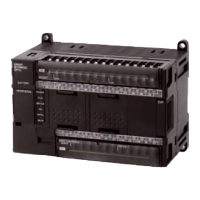
